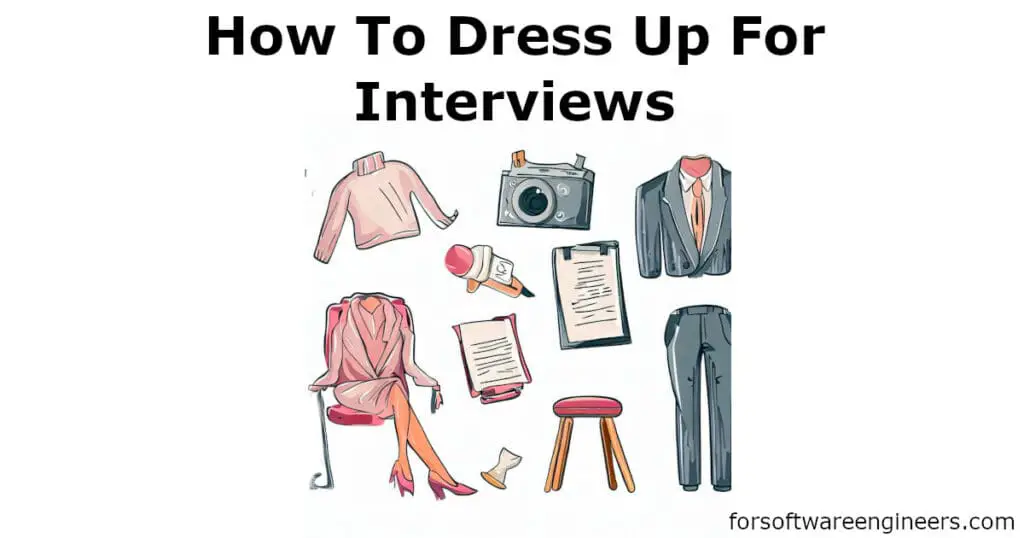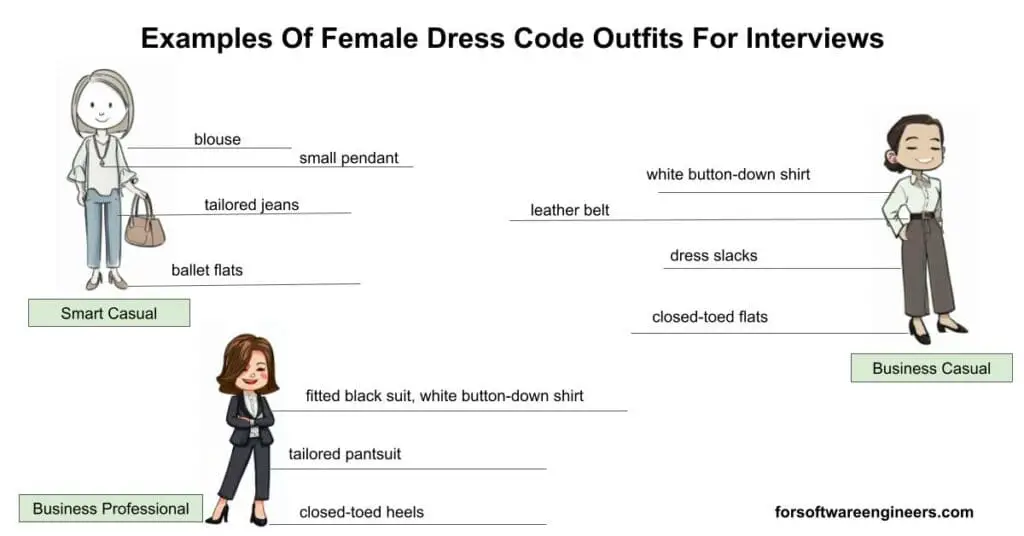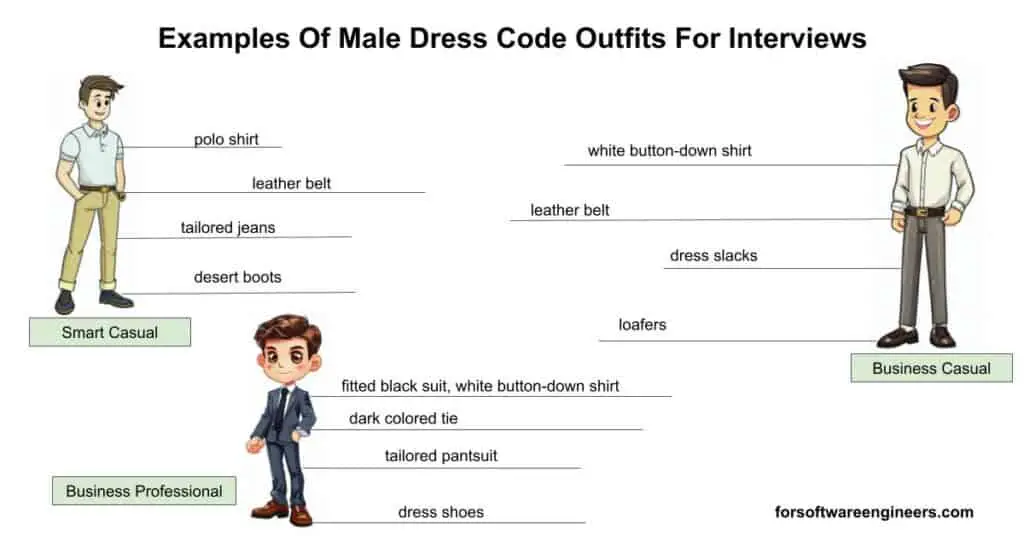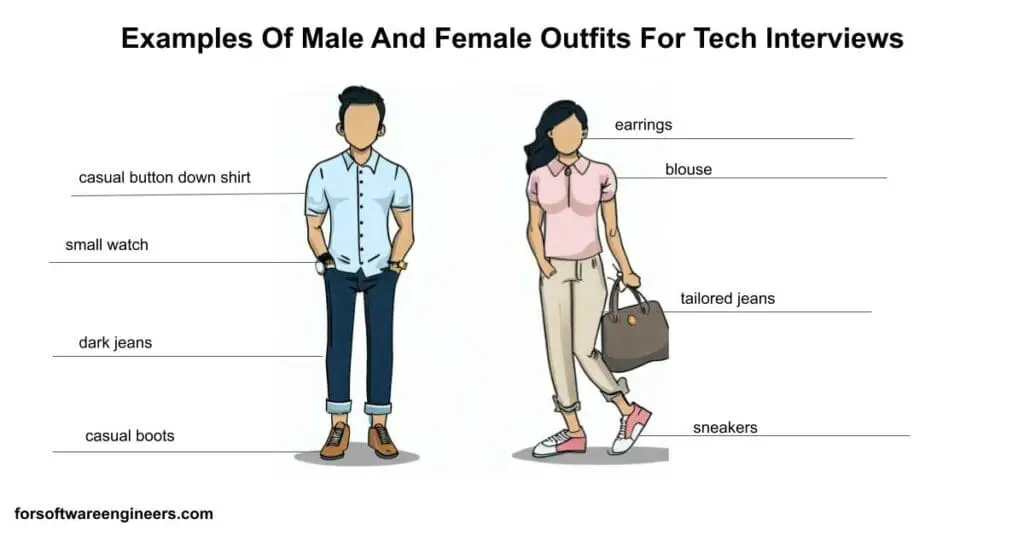How To Dress For An Interview: Male and Female (Visual Examples)
Dressing for an interview means wearing appropriate clothing attire for a job interview. The appropriate clothing for a job interview is defined by an employer’s dress code which generally falls into three main categories of smart casual, business casual, and business professional attire. Each of these types of dress codes applies to both males (men) and females (women).

In this article, we’ll explain in more detail what the 3 main types of dress codes are for interviewing. Subsequently, we’ll give examples of what both females and males could wear according to each interview dress code, providing visual examples. At the end of the article, we’ll show some additional examples of outfits you could wear in different scenarios like a tech job interview when interviewing for a software engineering role and a remote interview (online interview).
What Is The Definition Of A Dress Code?
A dress code is a set of rules for what types of clothing attire should be worn during a location or event like an interview. A dress code is applied to all individuals, regardless of gender, and each gender traditionally applies the dress code to their attire in gender-specific ways.
What you wear during an interview process with a dress code expresses information to your employer about whether to hire you or not. This is why it’s important to learn about the 3 main types of interview dress codes, know about your prospective employer’s dress code, and follow your prospective employer’s specified dress code, regardless of the type of interviewing format you’re doing.
What Are The 3 Main Types Of Interview Dress Codes?
The 3 main types of interview dress codes are smart casual, business casual, and business professional, listed in ascending order of formality. It’s rare for an employer to request a dress code outside of these three main types for their interviews.
Listed below are descriptions of each of these different types of dress codes used in interviews.
- A smart casual dress code means to wear clean, polished, casual clothing. For males, this includes potentially wearing a collared shirt without a tie, and for females, this includes potentially wearing a nice sweater. This type of dress code has the least concrete set of expectations and rules.
- A business casual dress code means to wear attire that is more formal than everyday casual wear but not as formal as a traditional business suit. For men, it often means dress slacks, a collared shirt, and leather shoes, with optional tie and blazer. For women, it often means wearing a blouse with a skirt, dress pants, or a dress, paired with closed-toed flats or heels.
- A business professional dress code means to wear tailored, polished, and serious attire. For men, this means wearing a dark suit, light dress shirt, tie, and leather shoes. For women, this means wearing a tailored skirt or pantsuit, blouse, and closed-toed heels, with minimal, accessories. This type of dress code has the most concrete set of expectations and rules.
What Happens If You Don’t Follow An Interview Dress Code?
If you don’t follow an interview dress code, it could leave a more positive or more negative impression of you, depending on whether you’re “dressing up” or “dressing down” from a dress code. Dressing up means to dress more formally than the expected dress code, and dressing down means to dress less formally than the expected dress code.
Typically, dressing up will give your interviewer either a neutral or positive impression of you because they could interpret it as you’re doing everything within your control to leave the best first impression. For this reason, it’s never a bad idea to dress upwards if you don’t know what a dress code is.
However, dressing down is highly discouraged because it will most likely leave your employer thinking that you’re unprofessional.
How Do You Know What The Interview Dress Code Is?
You’ll know what an interview dress code is by talking to your recruiter or your point of contact for the interview. They should tell you what the interview dress code is for the interview you’re doing. Alternatively, you can look on Google for what the dress code is for the job role and industry you’re interviewing for. Dress codes are typically the same across combinations of job roles and their industries.
How Should You Dress For An Interview As A Female?
As a female, you should dress in a way that conforms to the dress code that an employer requires for their interviews. For smart casual, this includes wearing attire like a relaxed-fit blouse, tailored jeans, and comfortable ankle boots. For business casual, this includes wearing attire like a collared button-down shirt, dress slacks, and low heels. For business professional, this includes wearing attire like an ironed white button-down shirt, a tailored pantsuit, and classic closed-toe heels.
The image below depicts visual examples of what to wear as a female for smart casual, business casual, and business professional.
[Image of dress codes for women, smart casual, business casual, business professional]

What Should Females Not Wear To Interviews?
Listed below are 10 pieces of attire that females should not wear to interviews because it could leave a negative impression on interviewers and employers. These items are inappropriate for both genders to wear during interviews but are traditionally worn more often by women.
- Graphic tees: These give an impression of not taking the interview seriously.
- Sweatpants: Such attire can make one seem unprepared for an interview environment.
- Flip flops: Wearing them can make one appear less serious about the interview.
- Overly distressed tops: They suggest a lack of attention to detail for interview settings.
- Leggings as pants: They might not align with the expected standards of interview attire.
- Sheer blouses without appropriate undergarments: Such attire could divert attention away from the interview discussion.
- Tops with slogans: They can detract from the professionalism expected in an interview setting.
- Mini skirts: Such a choice can be considered too casual for interview proceedings.
- Open-toed shoes: They may not meet the standards of some interview dress codes.
- Flashy costume jewelry: Such items can overshadow the main purpose of the interview.
Can Females Wear Dresses To Interviews?
Yes. Females can wear dresses to interviews. There are different types of dresses that conform to the main three types of interview dress codes that can be worn, and they will not be perceived as negative to an employer.
How Should You Dress For An Interview As A Male?
As a male, you should dress in a way that conforms to the dress code that an employer requires for their interviews. For smart casual, this includes wearing attire like a polo shirt, chinos, and loafers. For business casual, this includes wearing attire like a collared button-down shirt, dress slacks, and leather loafers. For business professional, this includes wearing attire like a full suit, an ironed white dress shirt, a tailored pantsuit, and polished dress shoes.
The image below depicts visual examples of what to wear as a male for smart casual, business casual, and business professional.

Can Males Wear Shorts To Interviews?
No. Males can’t wear shorts to interviews. Even within the most casual dress codes, shorts are not permitted to be worn by males because it’s too casual for an interview setting.
What Should Males Not Wear To Interviews?
Certainly! Here’s a list of items typically considered inappropriate or too informal for each category for males:
- Graphic tees: Wearing these to an interview suggests a lack of professionalism.
- Tank tops: Opting for tank tops for an interview is too casual and doesn’t convey seriousness.
- Baggy sweatpants: Such attire gives an impression of being unprepared for the interview setting.
- T-shirts with logos or bold prints: These can distract from the interview’s professional tone.
- Jeans with holes: Bringing these to an interview might be perceived as careless or informal.
- Cargo shorts: Wearing these shorts is too casual for most interview environments.
- Athletic sneakers: Choosing these for an interview doesn’t align with the formality expected.
- Short-sleeved dress shirts: For an interview, they’re often seen as less formal than long-sleeved ones.
- Novelty ties: Wearing such ties to an interview can distract and may not convey seriousness.
- Flashy cufflinks: Using overly decorative cufflinks during an interview might divert attention and seem ostentatious.
What Are Examples Of Outfits For A Job Interview In Different Scenarios?
In the sections below, we’ll describe examples of how both men and women should dress for job interviews in different circumstances like a tech interview and Zoom interview.
What To Wear To A Tech Job Interview
The image below depicts example outfits of what both men and women can wear in a tech job interview.

This is how you should dress if you’re doing an interview in the tech industry like a coding interview in which you want to pass, for software engineers.
What To Wear To A Zoom Interview
Listed below are examples of what you could wear to a Zoom interview (online interview) with a casual dress code.
Men:
- Tops: Dress shirt or neat polo.
- Bottoms: Dress slacks.
- Shoes: Optional, but avoid slippers.
- Accessories: Good quality headphones if needed.
Women:
- Tops: Professional blouse or shirt.
- Bottoms: tailored pants or skirt.
- Shoes: Optional, but avoid slippers.
- Accessories: Good quality headphones if needed.
Should You Dress Head To Toe In A Virtual Interview?
Yes. You should dress head to toe in a virtual interview even if your interviewer will only see what you’re wearing from your mid-section and up. This helps you get into an interviewing mindset and be present in the interview which improves your chances of passing the interview.

